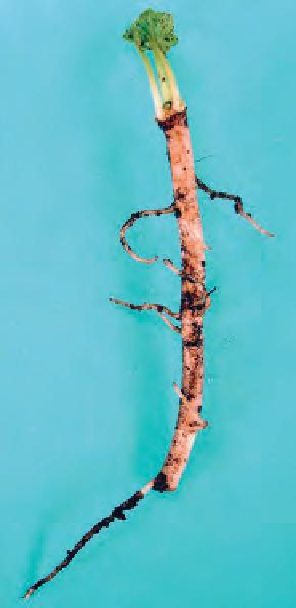Agriculture Reference
In-Depth Information
with half their length immersed in deep container
with a cuttings compost (Figure 11.12) or in a Dutch
Roll (see companion website). In
Hydrangea
spp.
and
Ribes
spp. (currants), the stems show evidence
of pre-formed adventitious roots (root-initials) that
help the process of root establishment. A 12-month
period is often necessary before the cuttings can be
lifted.
Root cuttings
are used for species such as
Papaver
orientalis
cvs (poppy),
Primula denticulate
cvs,
Phlox
paniculata
,
Acanthus spinosus
and
Anchusa azurea
(alkanet). For most species, young roots about a
centimetre in thickness are removed close to the
crown of the plant in late autumn/winter. These are
cut into 3-5 cm lengths and inserted vertically into a
cutting compost. It is important that these cuttings
are not put inadvertently upside-down as this prevents
establishment; the convention is that the top is cut off
square whereas the bottom cut is made on the slant.
However, the thinner-rooted species such as
Phlox
are
placed horizontally in a tray then covered with a
thin layer of compost.
These root cuttings are lightly watered and put in a
cold frame. When there are signs of growth, the root
development can be checked carefully and potted on
individually when well rooted (Figure 11.13).
Further information on vegetative propagation can be
found on the companion website: www.routledge.
com/cw/adams.
11
Figure 11.13
Rooted root cutting of
Acanthus
spinosus
Leaf-bud cuttings
comprise a short piece of semi-
ripe stem, an axillary bud (see p. 85) and the leaf (or
leaves) at this node. Several cuttings can be made
from each stem which is cut with sharp secateurs
between nodes, such as for
Clematis
spp.
and
Lonicera
spp.
(honeysuckles),
or, for difficult species
such as
Camellia
spp. (susceptible to rotting), just
above one node and below the lower one.
Hardwood cuttings
are from pieces of dormant
woody stem containing a number of buds, which
grow out into shoots when dormancy is broken in
spring. Some plants such as
Salix
spp. and
Populus
spp. root so easily that little more is needed than
pushing the well-ripened wood of the current season
into the soil. The more usual procedure, such as for
Buddleja
spp.,
Cornus
spp. (dogwoods)
, Deutzia
spp.,
is for the cuttings to be taken in late autumn. The
base of the cutting is cut cleanly at 45°
to expose the
cambium tissue from which the adventitious roots
will grow; the top is cut at right angles to the stem to
give a length of 15-25 cm. These are usually placed
Further reading
Hartman, H.T. et al. (1990)
Plant Propagation,
Principles and Practice.
Prentice-Hall.
Lamb, K. et al. (1995)
Grower Manual 1 - Nursery
Stock Manual
.
Grower Books. Swanley.
Macdonald, B. (2006)
Practical Woody Plant
Propagation for Nursery Growers.
Timber Press.
McMillan Browse, P. (1999)
Plant Propagation
. 3rd
edn. Mitchell Beasley.
Toogood, A. (ed.) (2006)
RHS Propagating Plants
.
Dorling Kindesley.
Toogood, A. (2002)
Growing from Seed.
Dorling
Kindersley.
Toogood, A. (2003)
Plants for Cuttings.
Dorling
Kindersley.
Please visit the companion website for further information:
www.routledge.com/cw/adams



